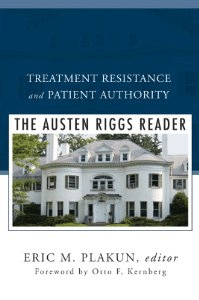“Treatment Resistance and Patient Authority: The Austen Riggs Reader”

“Treatment Resistance and Patient Authority: The Austen Riggs Reader”
Edited by Eric M. Plakun
W.W. Norton & Co.
New York, N.Y., 2011
Approach used at Austen Riggs is highlighted
Reviewed by Paul Efthim, Ph.D.
When all else fails, clinicians and their patients turn to Austen Riggs.
Founded in 1919, this 70-bed psychiatric hospital in small-town Stockbridge, Mass. has built an international reputation for its success with patients whom it refers to as “treatment resistant” – individuals who have had multiple ineffective therapy experiences, particularly those with severe personality disorders.
Unlike typical inpatient care, which focuses on stabilization and short-term interventions, the Austen Riggs approach places intensive psychodynamic therapy as the center of a treatment package that includes group work, medication, family and occupational therapies. Patients first complete a six-week evaluation phase that includes required projective testing (yes, you read that correctly – projectives have a cherished home at Riggs).
Further treatment usually continues on an open campus for months and sometimes over a year if necessary. Expensive? You bet, but insurance companies can and do contribute significantly to the cost of care for many (but not all) Riggs patients. Long-term outcome data points to impressive reductions in symptom severity and improvements in relational and occupational functioning.
Recently, psychiatrist Eric Plakun, M.D. and his colleagues at Riggs pulled together a group of previously published papers that describe the technical aspects of their unique approach. Taken together, this important collection offers an excellent hands-on guide to working with difficult-to-treat patients.
Drawing on the school of interpersonal psychiatry founded by Harry Stack Sullivan, the Riggs approach emphasizes the therapeutic value of human relationships. There is a strong focus on using the treatment alliance as an agent of change. For example, Plakun shows how suicidal behavior can be engaged as an interpersonal event between patient and therapist that can be explored from within the relationship rather than located as a symptom residing in the patient.
A bedrock Riggs principle is the notion that treatment resistance may result from a patient’s loss of authority, as he or she becomes a passive recipient of the doctor’s ministrations. As the authors point out, “Resistance to treatment may be the only way left for a patient to exercise authority if he or she has lived a life of abuse, loss, deprivation and neglect. Treatments work best when patient authority is restored within human relationships that include efforts to discover and translate hidden meaning and that do not shrink from facing a patient’s rage toward those in authority on whom he or she must nevertheless depend.”
Speaking of rage, Plakun’s chapter on working with the negative transference stands out. He notes that in many difficult cases, the main obstacle is the therapist’s own resistance to engaging the patient’s aggression and hate in the transference. One of his most important points bears quoting: “These patients suffer at least as much from too much hate that cannot be tolerated by others, including treaters, as they do from insufficient love.” Plakun presents a fascinating case showing how to engage a patient’s hatred and rage and utilize the negative countertransference in a thoughtful way that helps the person face and work with these previously feared feelings.
A total of 15 contributors, including psychologists, psychiatrists and clinical social workers, offer their perspectives on Riggs treatment in such domains as the analytic third, ethics and patient authority, the role of the therapeutic community and a chapter on intergenerational transmission of trauma by Gerald Fromm, Ph.D.
Noted psychiatrist Ed Shapiro, who led Riggs for about 20 years until his retirement in 2011, is well-represented with several chapters as well.
One might question why Riggs chooses to use the term “treatment-resistant patients,” which locates the resistance in the individual, even as they take pains to point out that the phenomenon of “resistance” is most certainly interpersonal and co-constructed. It seems certain that in time, another way of describing this group of patients will emerge.
The success of the Riggs model stems not only from their ability to offer high-quality and high-intensity treatment, but also from the nature of their work as a system. Patients can disperse negative transferences across multiple clinicians while they are working on these emotions in their individual therapy. This suggests the book might need a warning label for therapists in solo private practice: Don’t try this at home – at least not without a team of trusted colleagues to support you.
Paul Efthim, Ph.D. is a licensed psychologist in private practice in Brookline, Mass. He holds a faculty appointment at the Boston Institute for Psychotherapy and is a candidate at the Massachusetts Institute for Psychoanalysis.
Learn more about the book: Treatment Resistance and Patient Authority: The Austen Riggs Reader (A Norton Professional Book)
